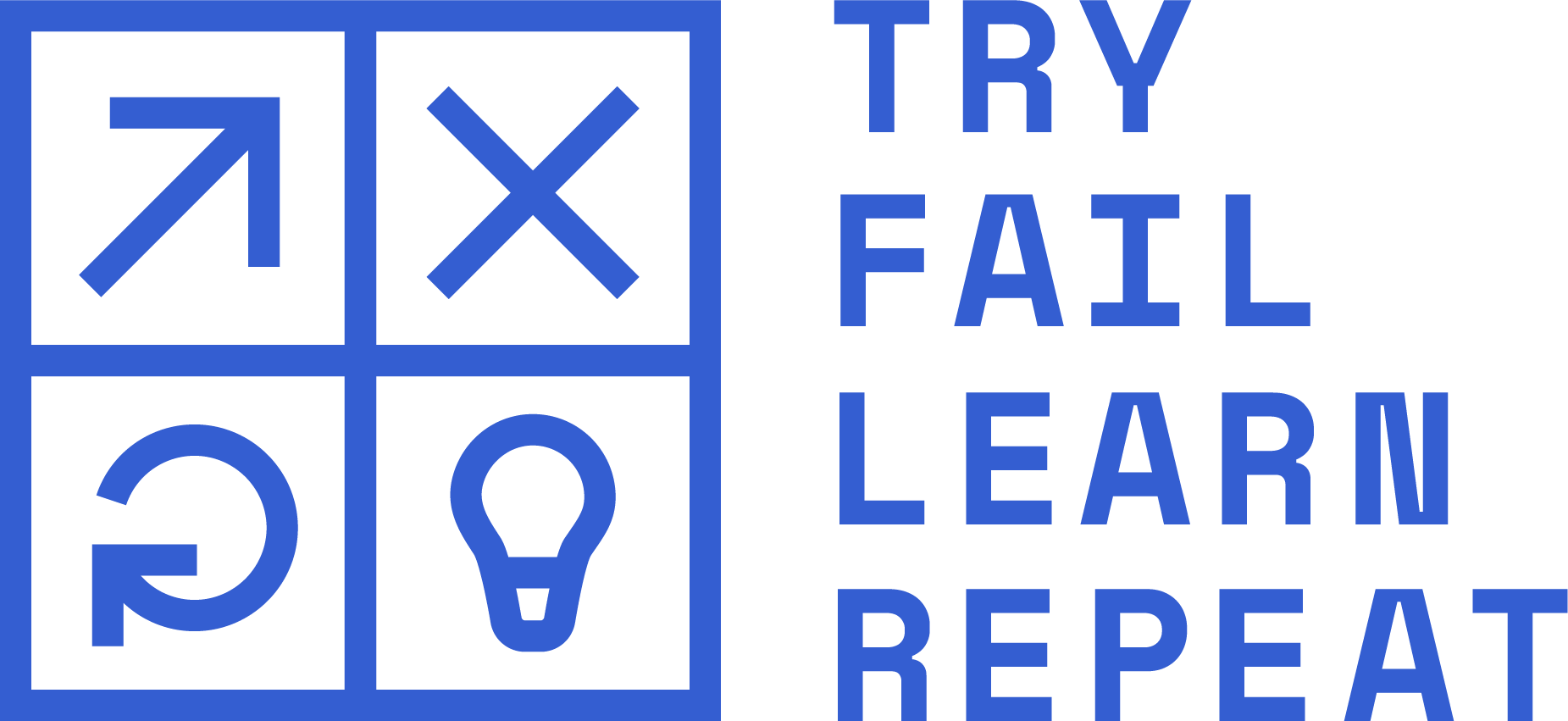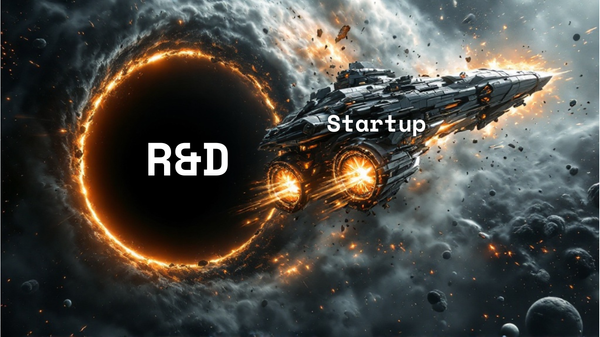Ray Kurzweils Predictions (2024 Edition)
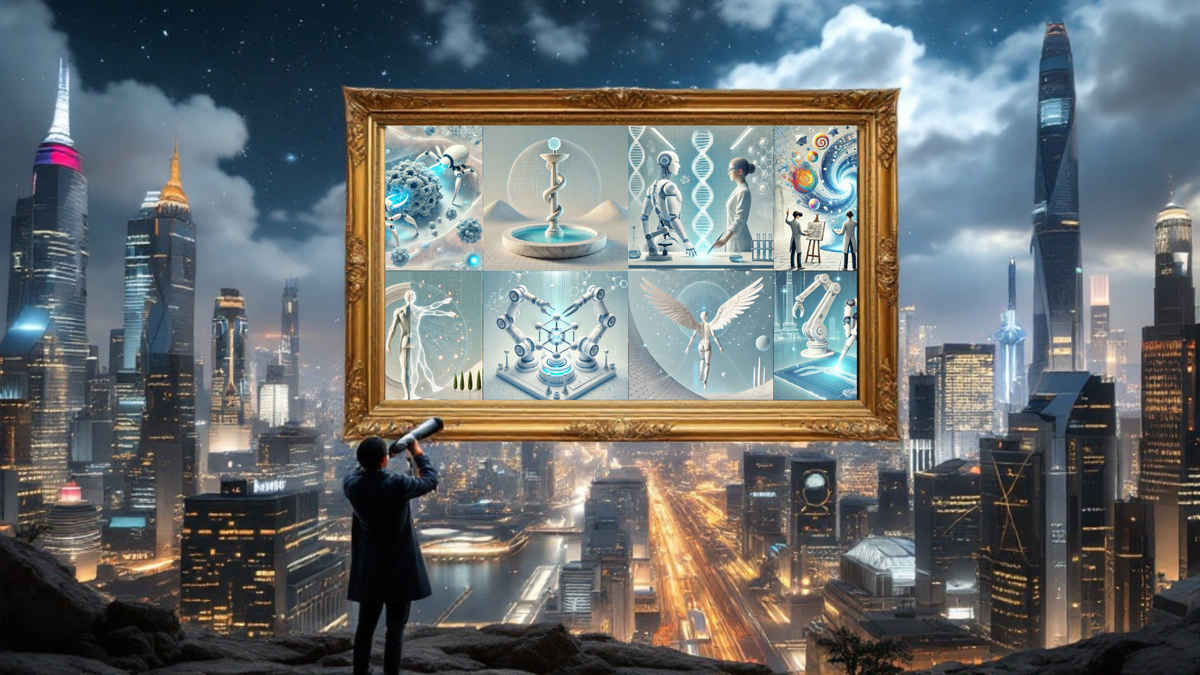
If you are interested in what technological developments we will see in the next ten to thirty years and what might be relevant for your own life, career, investment decisions or new start-up ideas, you can't ignore Ray Kurzweil and his books. In his latest book ‘The Singularity is Nearer’, he describes, among other things, how AI and nanotechnology will bring us to the point at which we reach ‘Longevity Escape Velocity’ (LEV). LEV is reached when technological and medical progress enables life expectancy to increase by more than one year every year - so with every year that passes, the average person gains one or even more than one year and can thus theoretically live forever.
Even if this sounds crazy and my personal opinion is that Ray Kurzweil is often very optimistic about the future, it is interesting to understand the basis on which he makes his predictions and how they are all connected.
After reading the book, I tried to categorize the predictions and put them in relation to each other. I categorized the predictions into two tracks:
- Predictions on society, energy and the future of manufacturing
- Predictions on the extension of human life: Outrunning the Grim Reaper
But first of all, who is Ray Kurzweil?
Ray Kurzweil is not only a visionary, but one of the most important minds in the field of artificial intelligence. Born in 1948, he studied computer science at the renowned MIT (Massachusetts Institute of Technology) and founded his first company after graduating.
He is the developer of numerous technologies, including the first OCR (Optical Character Recognition) system for text recognition and the first synthesiser capable of reproducing the sounds of a real instrument. During his career, he has received 20 honorary doctorates and is Director of Engineering at Google, where he works on the development of advanced AI systems.
What is Ray Kurzweil Renowned For?
What truly sets Kurzweil apart is his concept of the "Singularity"—a future moment when artificial intelligence (AI) will surpass human intelligence and cause an unprecedented acceleration in technological growth.
The term "Singularity" is borrowed from physics, where it describes a point beyond which we cannot predict events. In Kurzweil’s view, the technological singularity will occur when AI reaches superhuman levels, reshaping everything from medicine and science to art and human cognition. It’s a future in which technology and biology will merge, and humanity will take control of its own evolution.
What Did Ray Kurzweil Predict?
Kurzweil has made an astonishing number of predictions over the years—many of which have come true. For example, in his 1999 book The Age of Spiritual Machines, Kurzweil predicted that by the early 21st century, we would see:
- Ubiquitous, portable computers that provide constant access to information—essentially predicting the rise of smartphones and mobile internet.
- AI systems capable of diagnosing medical conditions better than human doctors—a vision now coming to life with AI-powered diagnostic tools.
- Virtual reality becoming part of our everyday lives, paving the way for immersive environments like today's metaverse.
In his seminal 2005 work The Singularity is Near, Kurzweil took his predictions even further, foreseeing:
- The ability to back up and transfer human consciousness into digital form
- The exponential rise of nanotechnology
- The merging of human brains with AI
Kurzweil's ability to foresee trends in AI, biotechnology, and computing has earned him a reputation as one of the most accurate and insightful futurists of our time. His predictions are based on a deep understanding of exponential growth in technology, which he sees as the driving force behind many of the transformative changes coming our way.
Now, with his latest book, The Singularity Is Nearer, Kurzweil updates these predictions, offering fresh insights into how the near future may unfold.
Predictions on Society, Energy, and the Future of Manufacturing
Ray Kurzweil’s predictions span many fields, but a central theme is the fusion of humans with technology. Here are some of the key forecasts he makes about the general trajectory of technological progress and its impact on society.
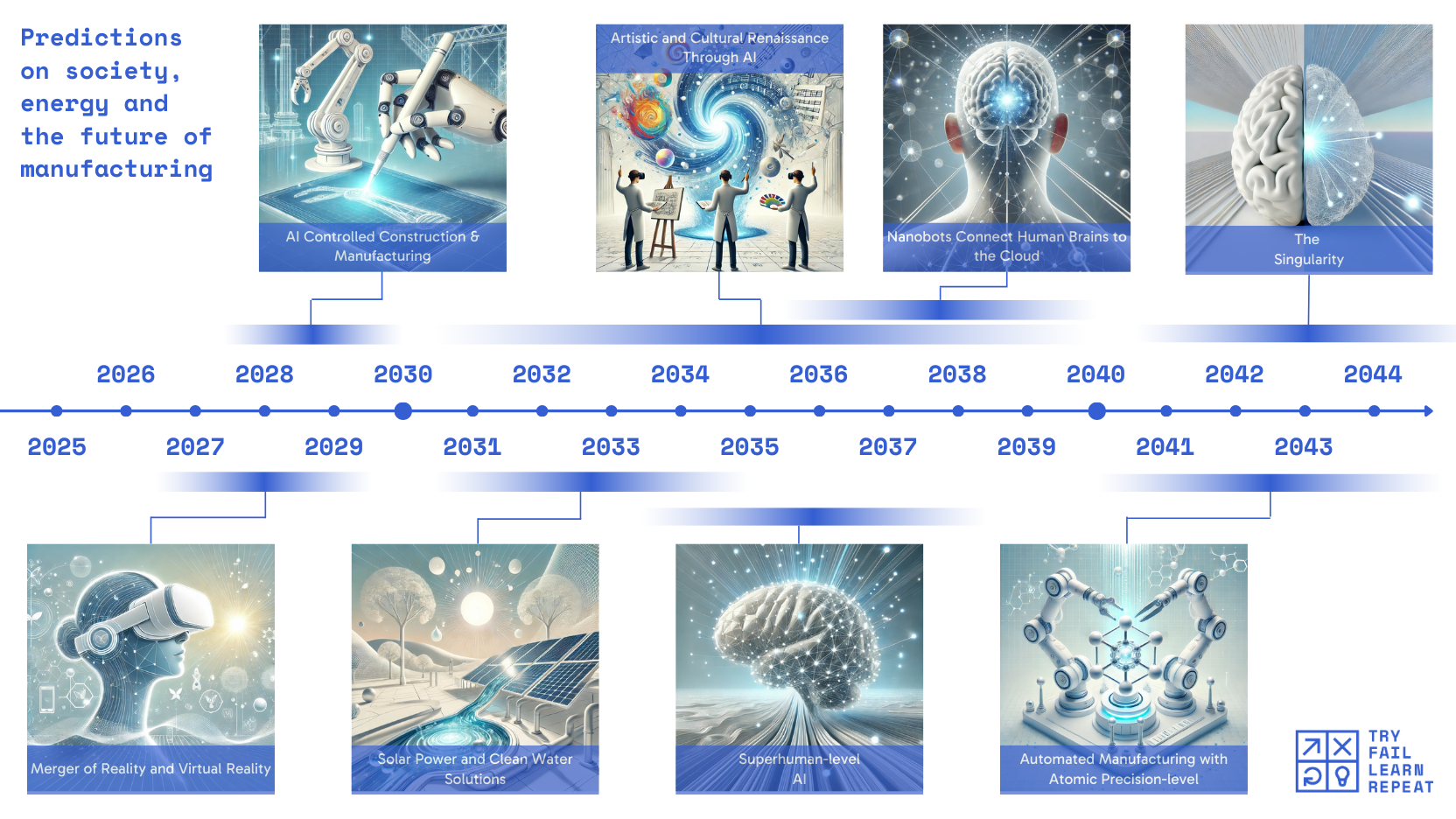
Late 2020s: Merging of Virtual Reality and Physical Reality
One of Kurzweil’s more immediate predictions is the blending of virtual reality (VR) with the physical world. By the end of the 2020s, advancements in augmented reality (AR) and virtual reality will bring about a seamless convergence of both realms, creating what some may call the metaverse. Our daily lives will be deeply integrated with VR, reshaping work, socialization, and entertainment.
I hope Ray Kurzweil considered the bulky design most AR/VR headsets still have - I think that plus the currently still high costs prevent mass adoption.
Late 2020s: Automated Manufacturing and Construction
Kurzweil envisions that by the end of this decade, many industries will be revolutionized by automation. Buildings will be constructed primarily by robots using prefabricated, 3D-printed modules. Additionally, hardware goods will become part of the information technology domain, with products such as clothing and food being produced using 3D printers.
My take on that: I’d be so happy if robots finally assemble the next IKEA furniture for me. And when there are some mysterious leftover screws left I’ll just assume AI found a smarter way to assemble it than the manufacturer!
Early 2030s: Solar Power and Clean Water Solutions
Sustainability also plays a central role in Kurzweil’s vision of the future. Solar power will dominate global energy production in the 2030s, outcompeting traditional energy sources. Clean water will become universally accessible thanks to advances in nanotechnology. Nanofilters will provide cheap and efficient water filtration, addressing one of the world’s most critical resource shortages.
I wonder why Ray Kurzweil is not envisioning fusion playing a major part in energy production. Maybe even he succumbed to the common joke that whenever you ask someone when we’ll have fusion power, the answer will always be “in 30 years”.
2030s: Artistic and Cultural Renaissance through AI and AR
As AI systems continue to evolve and integrate with human creativity, Kurzweil predicts a cultural revolution. By the 2030s, we will be able to create art and cultural experiences that are beyond the imagination of today’s human minds, thanks to the power of AR, AI, and neural connections to the cloud.
I believe in this future we’ll also be able to extend our scientific understanding of the world in profound ways. Take our perception of time, for instance: aside from our basic chronobiological mechanisms, like the Melatonin-Cortisol cycle, we don't have a direct way to 'sense' time as we do with space, where our eyes help us navigate three dimensions with clarity. However, advancements in AR/VR technology and our growing connection to cloud-based systems could give us new tools to perceive time more deeply. This might even help us grasp the relationship between time and other dimensions in a much more intuitive, experiential way.
Mid-2030s: Superhuman-Level AI
Kurzweil predicts that by the mid-2030s, we will achieve superhuman-level AI. This level of intelligence will far surpass human cognitive abilities and become an integral part of our daily lives, working alongside humans in every conceivable domain, from engineering to medicine.
Late 2030s: Nanobots Connecting Brains to the Cloud
Sometime in the 2030s, nanobots will take on a more cerebral function, linking our neocortex to the cloud. This would enable communication between biological neurons and digital neurons, expanding our mental capabilities.
2040s: Fully Automated Manufacturing with Atomic Precision
Kurzweil believes that by the 2040s, manufacturing will be fully automated and through the use of nanotechnology, be capable of producing items with atomic-level precision. This will drastically reduce costs and waste, ushering in an era of limitless abundance. I read Neal Stephenson's “Diamond Age” more than a decade ago, and it seems Ray Kurzweil believes that science fiction is becoming reality in the not-too-distant future. In Diamond Age, nanotechnology plays a central role, where matter compilers can assemble anything from raw atoms, creating a world of unprecedented abundance (1).
2040s: The Singularity and Hybrid Intelligence
By the 2040s, Kurzweil believes we will reach the technological singularity—a point at which human and machine intelligence will blend seamlessly. Our minds will operate as a hybrid of biological neurons and cloud-based digital extensions, allowing us to think, create, and compute at a pace and scale unimaginable today.
But what about venturing into space? Ray Kurzweil doesn’t cover the exploration of space in his book. I believe humanity inevitably will expand into space - but how will the singularity, this blend of intelligence adapt? What happens when we leave the Earth-bound cloud behind? Or will humans venturing into space become "stand-alone" beings, temporarily disconnected from Earth's centralized digital networks, or if we’ll develop decentralized, interplanetary solutions like IPFS (InterPlanetary File System) to keep us connected?
Predictions on Human Life Extension: Outrunning the Grim Reaper
One of Kurzweil’s most well-known passions is the quest for life extension, and “The Singularity Is Nearer” provides an array of intriguing forecasts about how science and technology will extend the human lifespan far beyond its current limits.
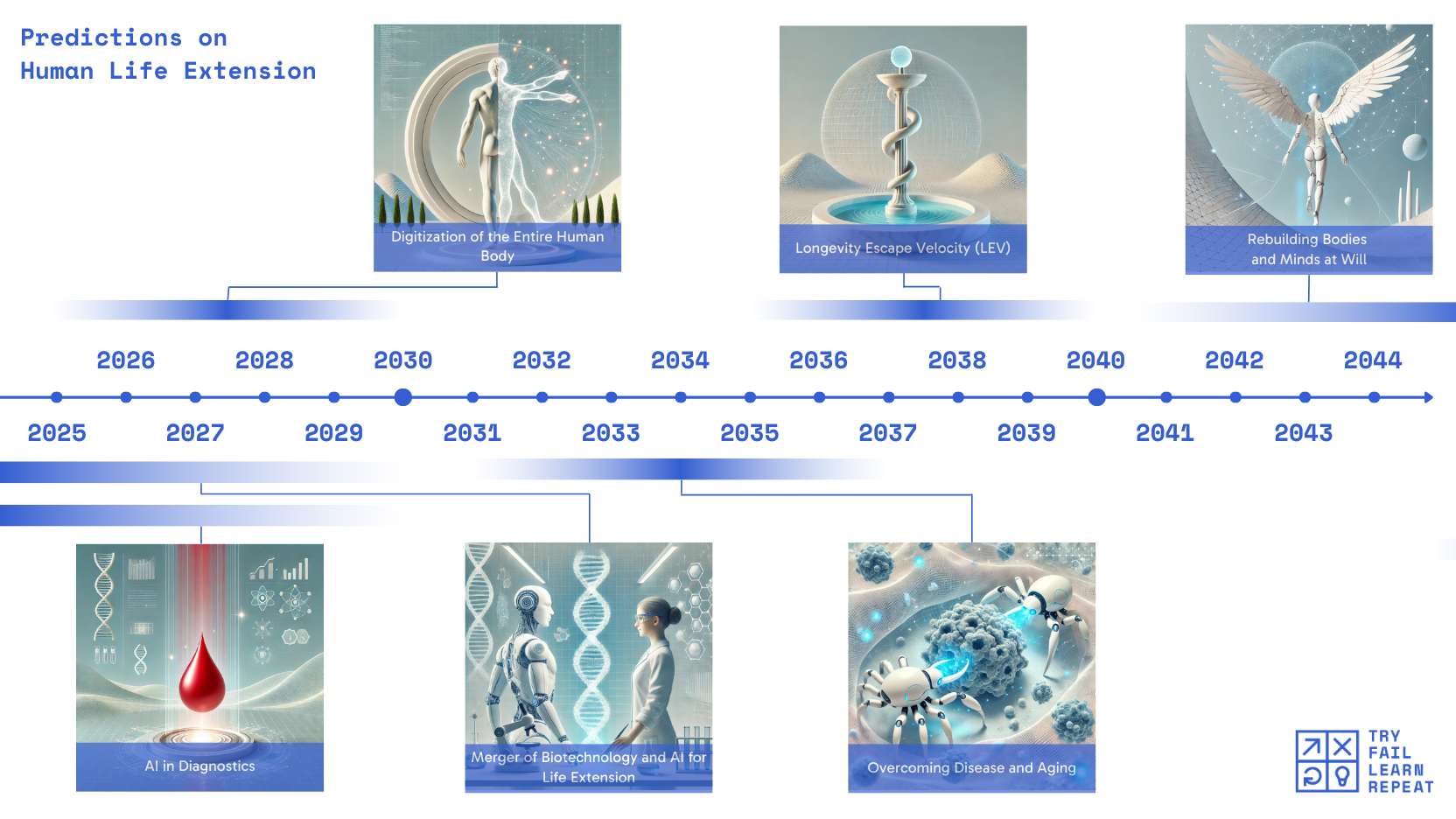
2020s: AI in Diagnostics: Kurzweil's Prediction is Becoming Reality Already
In the 2020s, Ray Kurzweil predicts that AI-powered tools will surpass human abilities in diagnostic tasks. AI systems, particularly in medical imaging, are already outperforming specialists in detecting conditions like lung and breast cancer. For example, a recent Lancet paper reports that AI-supported breast cancer screening has been shown to be just as accurate but significantly more efficient than a control group of oncologists working without AI assistance (2). Another indication that Kurzweil is likely to be right in this aspect is that the FDA is already approving hundreds of AI-based radiology tools (3). In other diagnostic areas, the implementation of AI is not yet as advanced, but experts expect a strong increase in the importance of AI in areas such as clinical chemistry and hematology, especially in the early detection of diseases from laboratory data, the recognition of complex patterns and thus possibly even the identification of new biomarkers for diseases (4).
2020s: Merger of Biotechnology and AI for Life Extension
In the near term, Kurzweil predicts that the 2020s will see significant advancements in life extension, thanks to the integration of biotechnology with AI. This "second phase" of life extension will enhance the human body's ability to repair itself and slow down aging at the cellular level (after the “first phase” which brought modern pharmaceuticals and treatments from 150 years ago until the present time).
In other words, the "fountain of youth" could be real—just with a lot more data, nanobots and algorithms than anyone expected.
End of 2020s: Digitization of the entire human body
Kurzweil predicts that by the late 2020s, we will have achieved significant advancements in simulating all bodily functions at the cellular and molecular level using AI. This breakthrough will dramatically accelerate drug development, as traditional human clinical trials will largely become unnecessary.
Beginning of 2030s: Overcoming Disease and Aging
Kurzweil predicts that by the early 2030s, nanobots will revolutionize healthcare. These tiny machines will roam the human body, repairing damage, eliminating pathogens, and even extending lifespan by fighting the aging process at a cellular level. This will be the dawn of the "third phase" of life extension, when medical nanorobots will operate at a cellular level to repair damage and slow down or reverse aging.
I have to admit, I was initially a bit skeptical about the role of nanotechnology in overcoming disease and aging, mainly because my expertise lies more in pharmaceuticals and life sciences. However, around the time I was reading Kurzweil’s book, I came across news from the renowned Karolinska Institute, where researchers successfully used nanorobots to target and destroy cancer cells in mice (5). While I believe that regulatory challenges, unforeseen developments, and obstacles will likely push Kurzweil’s timeline further into the future, I’m genuinely inspired by the breakthroughs we’re already seeing in the lab. The progress so far demonstrates that nanotechnology might indeed play a transformative role in future medicine, even if it takes a little longer than predicted.
Late 2030s: Longevity Escape Velocity
Perhaps Kurzweil’s boldest prediction is that by the late 2030s, the most health-conscious and tech-savvy individuals will reach what he calls “longevity escape velocity.”, they’ll have access to the fountain of youth. For each year that passes, medical advancements will increase life expectancy by more than one year. In other words, these individuals will effectively outrun death, extending their lives indefinitely.
Some people even predict that we will one day be able to turn back our age and become younger - just like in the movie “The Curious Case of Benjamin Button” (6).
2040s-2050s: Rebuilding Bodies and Minds at Will
In the more distant future, Kurzweil forecasts that by the 2040s and 2050s, we will be able to rebuild our bodies and brains at will. Nanotechnology will allow us to produce bodies that are faster, stronger, and more resilient, with the ability to think at rates millions of times faster than we do today. Most astonishingly, we will no longer be dependent on our physical bodies for survival, as our consciousness will be backed up to the cloud.
Conclusion: The Optimistic Future of Ray Kurzweil
Kurzweil’s predictions are audacious, intriguing, and undeniably optimistic. He paints a future where technology solves humanity’s most pressing problems—curing diseases, ending aging, achieving sustainability, and merging human minds with digital intelligence. Whether or not all these predictions will come true remains to be seen, but one thing is certain: we won’t have to wait too long to either verify or falsify his visionary timeline.
References
- Stephenson, N. The Diamond Age. (Penguin, London, 2011).
- Lång, K. et al. Artificial intelligence-supported screen reading versus standard double reading in the Mammography Screening with Artificial Intelligence trial (MASAI): a clinical safety analysis of a randomised, controlled, non-inferiority, single-blinded, screening accuracy study. The Lancet Oncology 24, 936–944 (2023).
- Fornell, D. FDA has now cleared 700 AI healthcare algorithms, more than 76% in radiology. https://healthimaging.com/topics/artificial-intelligence/fda-has-now-cleared-700-ai-healthcare-algorithms-more-76-radiology (2023).
- Santos-Silva, M. A., Sousa, N. & Sousa, J. C. Artificial intelligence in routine blood tests. Front. Med. Eng. 2, 1369265 (2024).
- Wang, Y. et al. A DNA robotic switch with regulated autonomous display of cytotoxic ligand nanopatterns. Nat. Nanotechnol. 19, 1366–1374 (2024).
- The Curious Case of Benjamin Button. (2008).
